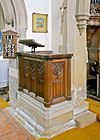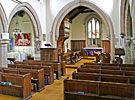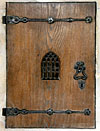Elston All SaintsFeatures and Fittings
Font
 Font Font |
The small octagonal stone font situated at the back of the south aisle is of Lincolnshire Limestone, diameter 20”, dates back to the 14th century. It still has signs of the original staple and hinge of its original cover. It was moved to its present position during the restoration of the church in 1912 and placed upon a raised stone step. The oak linen fold panelling either side of the font also dates back to 1912.
Pulpit
 Pulpit Pulpit |
The Mansfield stone plinth upon which the pulpit stands along with the steps, showing distinctive green-grey seams in certain blocks was presented by Francis Darwin in 1888.
The wooden pulpit dates to the late 19th century and is in memory of Gerald Lascelles Darwin, son of Francis and Charlotte Maria Darwin, who died in 1888. He was born on 25th November 1852.
Pews
 Pews Pews |
The pews have been changed on several occasions over the last 200 years. The present wooden pews came from St Leonard’s Church, Newark in May 1977.
Lectern
 The plain wooden lectern dates back to the late Victoria/early Edwardian era. The plain wooden lectern dates back to the late Victoria/early Edwardian era.
Litany Desk
The oak litany desk dates back to the late Victorian/early Edwardian era with the same high decorative style as the wooden lectern.
Altar/Communion Table
The plain wooden communion table dates back to 1912 along with the altar rails which were a gift of Colonel Darwin, for many years Patron and landowner of Elston. Extensions to the oak altar rails were added in 1988. The oak linen fold panelling either side of the altar also date to 1912.
Piscina
 Piscina Piscina |
 Aumbry Aumbry |
The piscina and the aumbry were installed in 1912 by the Darwin family.
The Royal Coat of Arms
 Royal Coat of Arms Royal Coat of Arms |
High up above the chancel arch lies the Royal Coat of Arms put up in the reign of Queen Victoria marking the sovereign’s position as Head of the Church of England. This has been repainted over the past 30 years. It is made of cast iron and appears identical in form to those in churches in Berkshire, Devon, and four examples in Lincolnshire, together with two now in the Peterborough museum.
|